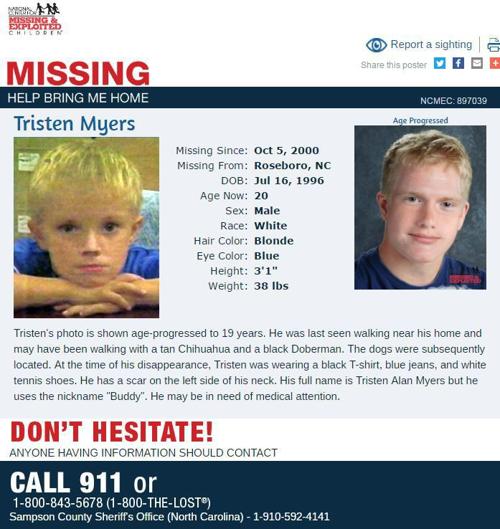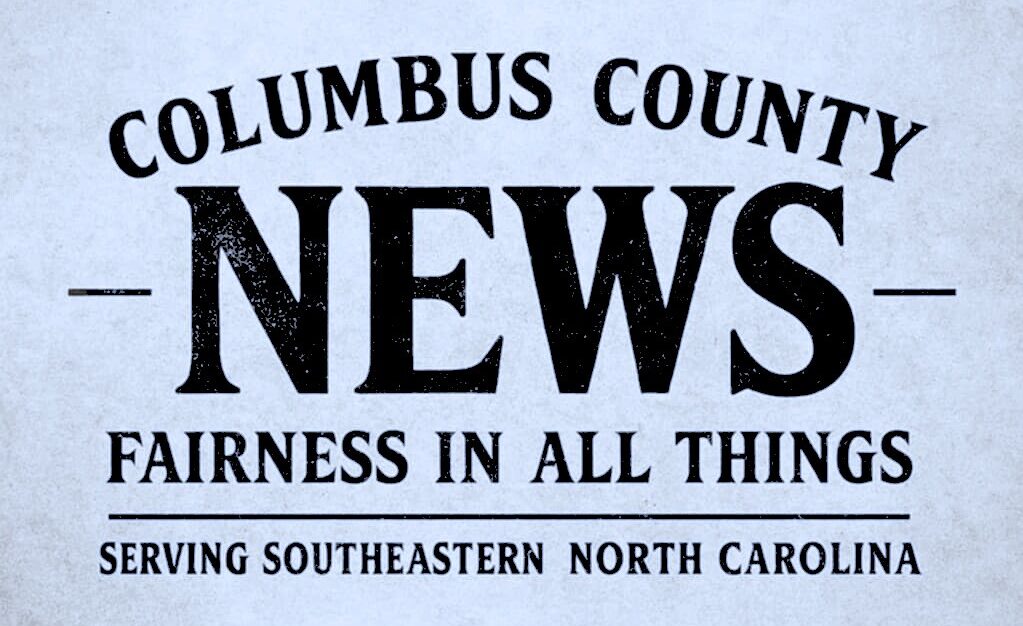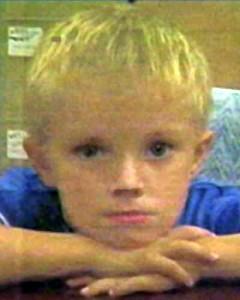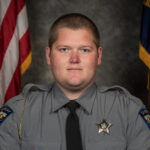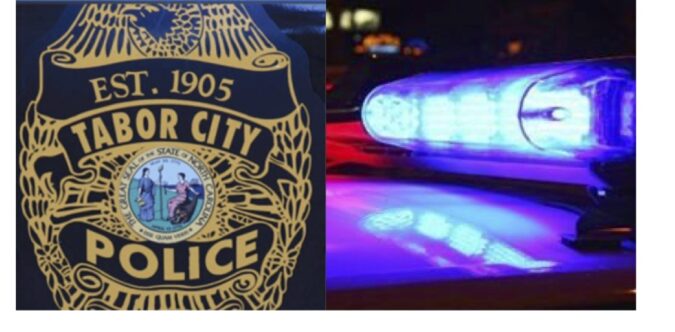Every missing person is somebody’s child.
The yellow ribbons are gone and forgotten now.
We put yellow ribbons up to welcome people home, or remind folks of those who haven’t yet come home. I never paid that much attention to them until after one night in 2000, when I first heard of a little kid named Tristen “Buddy” Myers.
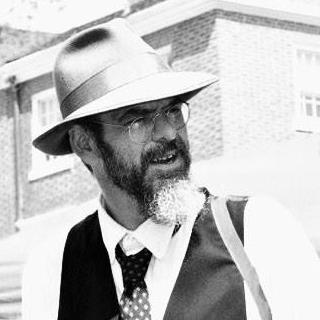
I say one night, but that’s not accurate. We intensively searched for Buddy for three days and nights. Other than some footprints that might have been old, and a toy dinosaur, no trace was ever found of a little kid who seemed to have finally caught a break.
Buddy’s mom Raven wasn’t much more than a child when she had him. He went to live with his grandmother, but she was sick and couldn’t handle a toddler, so Buddy went to live with his Uncle John and Great-Aunt Donna.
They were more the age of grandparents than parents, but their lives revolved around the little blonde boy with the great big eyes. He loves horses, NASCAR and football. At the age of four, he was excited about riding in John’s big rig. He had two dogs, a stable home in a good community, down a dirt road where traffic had to drive a little slower. He had a safe bed and good clothes and plenty to eat. There were horses at the neighbor’s place, a long baseball throw from the house, and he liked walking down there to visit them.
Buddy had it made.
But 20 years ago, at a modest brick home outside of Roseboro, around 4 p.m., something happened.
Buddy was playing in the living room (which hasn’t been changed since then, the last I heard). Donna sat down on the couch to watch Buddy. He got tired, as even the most energetic little boys do, and went to sleep. Donna nodded off.
When she awoke, he and his dogs were gone.
At 4 p.m. that day, I didn’t know something had happened yet, of course. It was 11 that night before I got the word. We had gone to bed and were about asleep when the phone rang. My parents and I all three were fulltime freelance writers for the Fayetteville Observer. My editor wanted me on Microwave Tower Road in Roseboro. There was a little boy missing, they were close to deadline and I knew the area.
So Miss Rhonda and I rolled out, the big Oldsmobile rumbling down Highway 24 a bit faster than legal; I was past deadline for one edition, fast approaching it for the second, and I figured diplomatic immunity would be in my favor, if any law enforcement officers weren’t busy searching for a little kid who was probably asleep under a piece of furniture. I did the same thing when I was his age, causing much consternation in the entire community, and earning a bottom-warming from a tearfully relieved mother.
As we turned down Microwave Tower, I was struck by the amount of dust in the air. We could see red taillights ahead of us, but the dust was almost a red-gold fog in the headlights. The home was on top of a hill, and the red clay of the area cut down visibility as effectively as a rainstorm until we were near the house.
Going up the last rise, I saw 10 or 15 flashlights shining into the sky, bobbing along as people moved about. Others pierced the red-gold dust, flashing over the fallow fields.
Voices were hollering “Bobby! Bobby!” People didn’t yet have the right name, but they would come to know Buddy too well in the days and weeks ahead.
Rhonda and I helped search that night, riding with a couple of Wildlife officers to check the neighbor’s horse barn, and taking a quick look down a woods trail jampacked with mosquitoes. ATVs and four-wheel-drive trucks that had been ready for the pending start of deer season instead rolled past, around and even through fields, lights lancing through the soybeans and late corn and pine thickets, tires spinning in the wet red clay around the pits used by the brick factory a few miles away.
We went home, I filed what I had, and the next day I headed back.
The professionals had arrived by then, the ones with the tracking dogs and the training. The owner of a closed Ford dealership opened the building and grounds for an incident command post. A Highway Patrol helicopter with an infrared radar system came in hot, touched down to pick up the chief deputy, and took off again. I was no longer the sole reporter on the scene – the TV stations brought their vans and even an RV. My dad felt good enough that day to join me for a while, so we shared a byline.
As the search effort grew, I met mantrackers from a dozen states. There was a native tracking crew from Robeson County, soldiers from Fort Bragg and Marines from Camp Lejeune, hunters who applied their knowledge of the ground and the woods and the deer trails to hunting a little boy instead. Not long after someone speculated Buddy might be hiding in a drain culvert, the helicopter pilot excitedly shouted into the radio that he had an IR “picture” of a shape about the size of the boy in a culvert. The rescue team found a hunting dog.
Yellow ribbon sold out at the florists in the area, to be wrapped around poles and posts and car radio antennas and door handles. Miss Rhonda ran updates on the search on her radio program. Mother, Papa and I filed multiple stories a day.
I was reluctantly waiting my turn to speak to Donna when I saw and heard this bossy, driven woman politely haranguing the chief deputy, a lifelong friend of mine. John just nodded his head and looked sad, as he often did, but this woman finally went back to sit with Miss Donna. For a minute, I wondered if I had the courage to go talk to her.
That was the day I met Monica Caison of the CUE Center for Missing Persons.
She really wasn’t as mean as I thought she was. She was just driven. Her entire being is focused on taking care of the families of missing people, and finding them. She was the one who taught me that every missing person is someone’s child. We became friends, and still are today, a bond forged over a lost little boy and so many others.
I let myself get too close to that story; it wasn’t like the other missing kids I’d seen, the ones hiding in a brush pile and giggling at the search crews (until they were terrified by a big, friendly, noisy bloodhound). The search had none of the drama and heroics of the kid found desperately clutching a tree after disobeying his parents and trying to canoe a swollen stream. There was none of the joyous relief of the little girl crying in the arms of the firefighter after she just wandered off picking blackberries and got lost.
There seemed to be no end in Buddy’s story. There still isn’t, for those of us who were there.
I could quote statistics about how many people vanish every year. Sometimes they are runaway kids, sometimes the kids are snatched by parents or by those with evil intent. Sometimes the missing are people who made very bad choices. Sometimes – more often than you might think – people just get fed up and leave everything and everyone behind.
Sometimes there is a trace of a trail, sometimes there is a body. Sometimes there’s an arrest or an involuntary commitment or a traffic citation.
Sometimes, however, there is nothing more than a toy dinosaur and a footprint.
Buddy Myers would be 24 years old now. He might be jumping from the airplanes that he used to watch flying over his home on their way the drop zones at Fort Bragg. He might be playing professional sports. He might be sweating his way through medical school. He might be driving big trucks like his Great-Uncle John. Shoot, he might even be a volunteer firefighter or law enforcement officer helping search for a missing child.
Buddy might be many things, but we don’t know.
It’s hard to speak of someone from 20 years ago in the present tense, but that’s kind of a rule in the missing persons world, if you don’t know what’s happened to someone. He or she “is.” They are not “was”. Using the wrong verb tense can be the last thread for a family holding out hope.
The official search was shut down after a few days, since a major weather system was coming in, bringing rain and cold temperatures.
There are so many unanswered questions in Buddy’s case, as there are in every unsolved missing case. Mother was filling in for me on the day of the last press conference at the Myers’ home, and happened to be the first one to notice two dogs trotting up the road to the home. Buddy’s dogs were clean and fed, not like dogs who have been wandering the woods with a little lost boy.
The story slowly faded, like those yellow ribbons, but for some of us, it never has.
Raven, Buddy’s mother, moved to the area to be closer to where her boy disappeared. She died in 2004 after fighting with a man and jumping from his truck. She was 23.
Buddy’s Uncle John passed away in 2015.
Donna still keeps a Christmas tree up for Buddy. There are presents for each Christmas and birthday waiting to be opened.
Monica Caison never forgets his name or the case, but then again, there are a lot of lost people on Monica’s heart at night. That’s just how she is. I couldn’t do it.
We still pray for his safe return quite literally every day, along with a handful of other folks who disappeared. A lot of other folks remember, too, but a more have forgotten. These things happen.
The yellow ribbons are gone and forgotten now, the last threads finally broken down by the sun or salvaged by birds building nests in the dogwood trees, privet hedges and blackberry brambles. The handbills in the windows are faded, forgotten, or replaced by photos of other missing persons.
It sounds wrong to say missing “persons,” even if you’re talking about an adult.
You see, every missing person is somebody’s child.
And Buddy is a child who will always belong to all of us.
